Just last week, I received the new Sangean ATS-405 on loan from Universal Radio. Though I’ve only had the radio for a week, I thought I’d share a few un-boxing photos (by request) and my initial impressions/review of this radio.
Unboxing
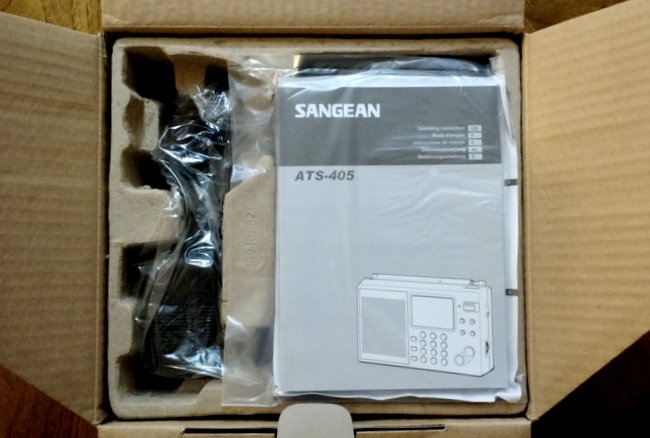 The ATS-405 comes with a thick owner’s manual (in five languages), a 7.5 volt AC adapter, and a soft radio case. The package does not contain rechargeable batteries nor a clip-on wire antenna (like many Tecsun products do, for example).
The ATS-405 comes with a thick owner’s manual (in five languages), a 7.5 volt AC adapter, and a soft radio case. The package does not contain rechargeable batteries nor a clip-on wire antenna (like many Tecsun products do, for example).
Overall, the packaging accommodates the radio and accessories efficiently and would probably ship safely even if the carrier doesn’t handle it with particular care.
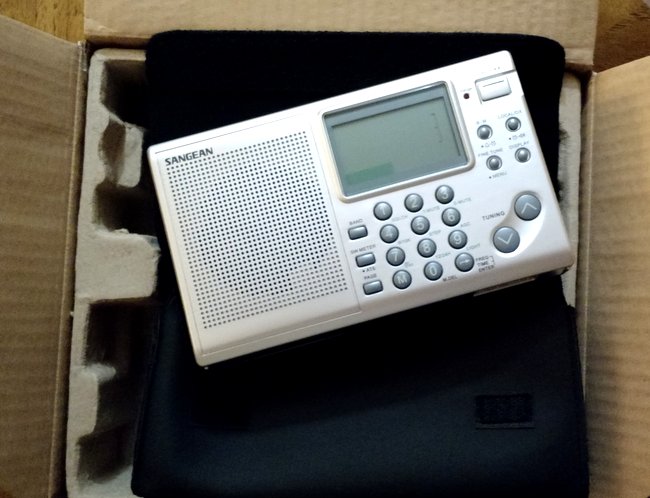 The first thing I noticed about the ATS-405 is the near-identical design and layout Sangean has used in their design of past shortwave radios. If you’re a Sangean fan, you’ll find all of the functions, buttons, and labels pretty much in the same place; virtually no learning curve.
The first thing I noticed about the ATS-405 is the near-identical design and layout Sangean has used in their design of past shortwave radios. If you’re a Sangean fan, you’ll find all of the functions, buttons, and labels pretty much in the same place; virtually no learning curve.
Performance: first impressions
After unboxing the ATS-405, I installed a fresh set of AA batteries in it and turned on the radio…
Display
Like most Sangeans, the display is crisp, clear and can easily be read straight-on or at low angles, like when the radio is resting on its back stand, for example. If you look at the display from a higher angle, however, you’ll find that the LCD digits nearly disappear.
Back-lighting is perfect: it’s soft and consistent across the display, very much like the ATS-909X.
Audio
Audio from the internal speaker is good. It’s in the same league with most similarly-priced competitors.
Receiver performance
Keeping in mind that I’ve only logged a few days of listening time on the ATS-405, I do have some initial impressions about receiver performance across the bands:
FM
On a positive note, I believe FM performance is quite good. Perhaps not in the same league with my PL-660 or PL-680, but still the Sangean offers above-average sensitivity. I was able to pick up my distant benchmark FM stations with ease, though to help with the signal lock, I had to switch from stereo to mono reception.
AM/Mediumwave
AM reception is a bit of a mixed bag. I find that the ‘405’s overall sensitivity and selectivity are quite good for broadcast band listening.
When I first tuned around on the AM broadcast band, however, I found the noise floor a little too high. Regardless of whether I was tuned in to a station or not, there was an ever-present high-pitched hiss, like static. It was quite disappointing, especially since I read a review by Jay Allen that really complimented the AM performance on the ATS-405.
I trust Jay’s reviews, however, so I promptly contacted him. Jay pointed out that the problem may be that I was listening in the default “wide” filter setting on AM. And indeed, he was right–though I had changed filter settings a few times while tuned to local stations, I had moved it back to wide and didn’t make note of this. (The ATS-405, by the way, has three filter settings: wide, medium and narrow.)
But the wide setting is really too wide, and was certainly the source for the bulk of the high-pitched hiss I heard. The best filter setting for most broadcast band listening is the middle position, which sounds like a 5-6 kHz filter. In the middle position, noise is decreased significantly. I also believe selecting the “music” audio tone setting helps dissipate some of the noise.
Regarding the noise floor: to be clear, I still feel like the noise level is slightly more noticeable, to my ear, on the ATS-405 than on the PL-660, PL-600, and PL-310ET when band-scanning or weak signal listening. This is most likely some internally-generated noise that somehow still meets Sangean’s engineering spec.
Local AM stations sound fantastic, and the ATS-405 can detect all of my benchmarks. AM audio fidelity is better than that of my PL-660 and, even, PL-310ET. When locked on a local station, the noise floor also seems to disappear. For some reason, I even find that the ATS-405 does a better job receiving local AM stations from indoors–even near noisy electronics–than other sub-$100 portables with which I’m familiar.
Uh-oh, birdies
The most disappointing discovery I made on the Sangean’s AM broadcast band is that it has DSP birdies. Birdies are internally-generated noises resulting from the outputs of the oscillators that form part of the DSP receiver circuit. While almost all receivers do have birdies somewhere in the receiver’s reception range, radio engineers try to keep them out of the way of the important parts of the band.
Unfortunately, my ATS-405 has strong DSP birdies on 800 and 1600 kHz. This is a big negative for me, since my favorite regional AM broadcast station is located on 1600 kHz (WTZQ). Rather than attempting to describe what the birdies sound like, here are a few audio clips that will give you an idea–I start with 1350 AM, which has no birdies and is representative of good AM reception:
WZGM 1350 kHz (broadcast sample with no birdie):
800 kHz (birdie on frequency with no broadcast signal):
WTZQ 1600 kHz (birdie on broadcast signal):
The ATS-405’s birdies almost sound like a jamming signal on 1600 kHz. Indeed, if this station were only located on a different frequency, I’m sure it would be quite audible on this radio…too bad.
Birdies on 800 and 1600 kHz may very well be deal-breakers for many of us. Again, since one of my favorite regional independent broadcasters is on 1600 kHz, it’s a deal-breaker for me.
Jay specifically mentioned a lack of birdies on the AM broadcast band in his review. It could very well be that he doesn’t hear them on his particular receiver–variations in quality control on a radio production line are certainly a real phenomena (the Grundig G3 is a case in point). This could indicate that some units may have pronounced birdies while others don’t. If you purchase an ATS-405, I would check to see if your unit has birdies after powering it up.
When I contacted an engineer for Sangean North America, and described my listening experience, he confirmed that he believed these are, indeed, DSP birdies. I may ask Sangean if they can send another ATS-405 for comparison.
On a more positive note, I checked harmonics in the HF/shortwave bands and heard no DSP birdies there.
Country of origin?
One additional question I posed to Sangean: where is the ATS-405 made? One reader told me the radios are produced in both Taiwan and China. Thinking variations in quality control may be accounted for by two different production lines, I checked my radio to see where it was made. Unfortunately, my unit has no mention of country of origin; not on the radio, the box, the manual, behind the battery cover, nor on the back stand. It’s possible it could be marked internally, but I didn’t want to take apart a receiver I’ve been loaned.
Sangean came back with a firm answer:
“I can confirm that the ATS-405, along with all our radios, are manufactured in China. We have an office in Taipei for engineering, sales, marketing and customer support.”
Not a big surprise here; I expected China was the country of origin.
To sum up AM performance: if you aren’t bothered by the birdies on 800 and 1600 kHz, or if your unit isn’t producing them, you’ll find the ATS-405 a capable little AM broadcast band receiver.
Shortwave
Our HF propagation conditions since last Friday (when I first turned on the ATS-405) have been poor. Other than a few short band openings, I’ve struggled to hear anything other than the normal blow-torch broadcasters we hear in North America. Still, bad propagation conditions are actually good for reviewing some aspects of a shortwave receiver, so I used the opportunity.
In terms of sensitivity on the shortwave bands, I think the ATS-405 is mediocre. It lags behind my Tecsun PL-660, PL-600, PL-310ET, and CC Skywave. Adding a clip-on wire antenna to the telescoping whip (there is no aux antenna port) does help in terms of sensitivity.
Since I do most of my listening on the shortwave bands, this, too, is a deal-breaker for me. If you primarily listen to stronger shortwave stations, or spend most of your time on the FM/AM bands, then you might still consider the ATS-405.
The ATS-405’s selectivity seems to be on par with my other DSP-based portables. In truth, though, band conditions have been so unfavorable, I don’t feel like I’ve had ample opportunity to test selectivity. I’ll likely follow up this initial review with an update.
And as on medium wave, the noise floor on the shortwave bands seems a little high to me–especially with the filter set to the “wide” position.
Cool, innovative features
While I clearly haven’t been wowed by the ATS-405’s shortwave performance, I have been more favorably impressed with some of its innovative features: specifically, the ability to control squelch, tuning mute, and soft mute.
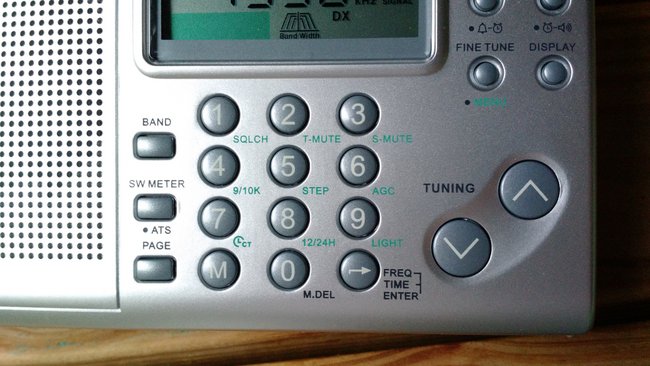 Using the menu button (see image above), you can engage or disengage the tuning mute and soft mute by pressing the “2” or “3” buttons on the keypad, then using the tuning up/down buttons to toggle these features on and off. Squelch works the same way, using the “1” button and volume control to set the threshold.
Using the menu button (see image above), you can engage or disengage the tuning mute and soft mute by pressing the “2” or “3” buttons on the keypad, then using the tuning up/down buttons to toggle these features on and off. Squelch works the same way, using the “1” button and volume control to set the threshold.
This menu control works regardless whether the radio is turned on or off.
Of course, by using the menu button and the keypad, you can also control the ‘405’s tuning steps, AGC, clock, and backlighting functionality; each of these are marked in green next to the appropriate button on the keypad (see image above), a very useful feature.
I wish other radio manufacturers would give users the ability to control some of the DSP chip’s built-in functionality, as the ‘405 does with the muting–especially since over-active soft muting has been the downfall of several DSP-based radios. Thanks for trail-blazing, Sangean!
Summary
Invariably, all radios have strengths and weaknesses; here is a list of my notes from the moment I put the ATS-405 on the air:
Pros:
- Improved features and controls:
- Soft Mute
- Tuning Mute
- Squelch
- AGC
- Crisp, clear display
- Good travel size, similar to the Grundig YB400
- Good AM/mediumwave sensitivity
- Three audio/tone settings: Music, Norm, and News
- Good FM sensitivity
- Dedicated mechanical switches for keylock, audio tone, FM stereo/mono, and charging.
Cons:
- Lackluster shortwave sensitivity
- DSP Birdies on 800 and 1600 kHz
- Higher SW/AM noise floor (especially in wide filter setting)
- No tuning wheel
- No AUX antenna port
- No shortwave SSB reception (AM only)
- No audio line-out port
I’m going to hold onto the Sangean ATS-405 for a few more weeks, as I’d like to give it a more thorough test on the shortwave bands. I hope to follow up with a post offering a few representative recordings.
My nutshell opinion of the ATS-405 so far is that it’s a decent little radio with a lot of functionality and features for a rig in its price class. But overall, its performance seems to me rather mediocre. If you primarily listen to FM, you’ll be pleased. If you’re a mediumwave listener, you’ll be pleased only if you don’t mind the 800/1600 kHz DSP birdies. If you’re primarily a shortwave listener, you’ll need to carry a clip-on wire antenna to bring the sensitivity up to the level of similarly-priced receivers.
In short, I do want to like this radio unreservedly. But it appears that Sangean may need to pull up its socks on their quality control. Readers: please comment if you’ve purchased the ATS-405–I’m very curious to learn whether there are QC discrepancies in performance from one unit to the next.
PLEASE NOTE: After publishing this following review, Sangean kindly agreed to dispatch a second unit for comparison.
Click here to read my update to this ATS-405 review.
Follow the tag ATS-405 for updates.
Sangean ATS-405 Retailers:
Many thanks to Universal Radio for supplying this radio, on loan, for review!

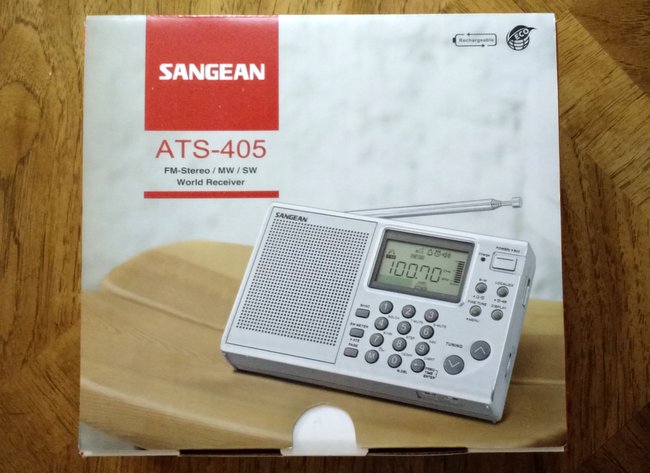
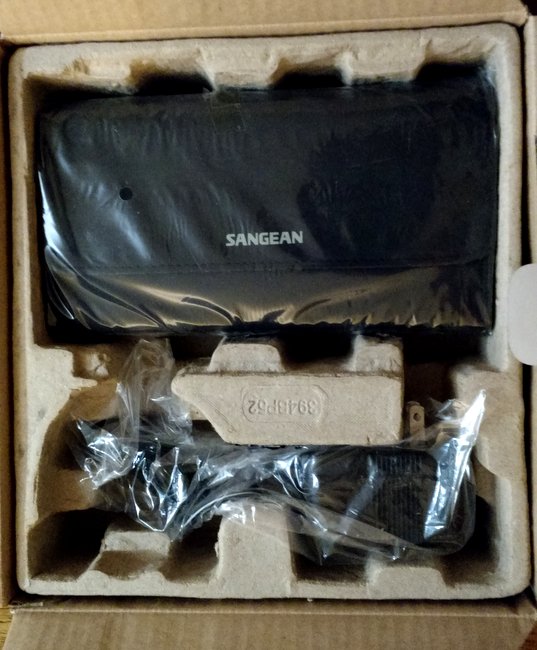
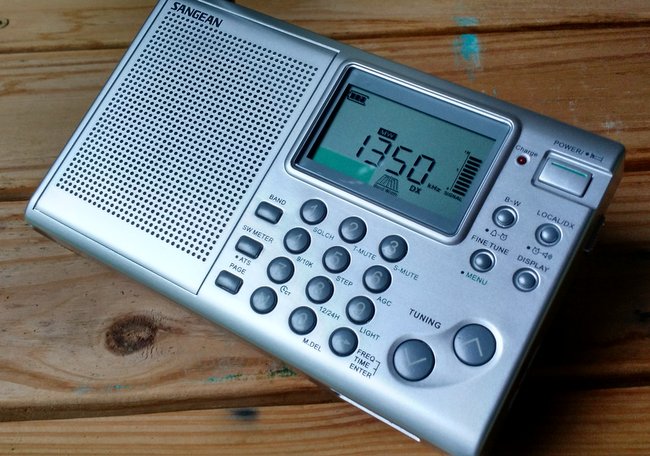
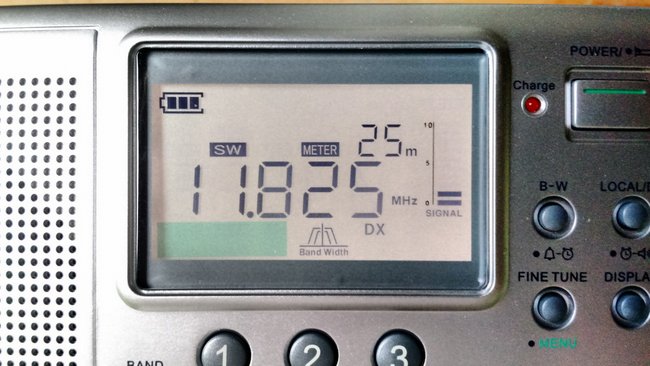
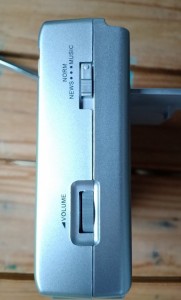
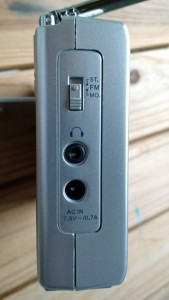
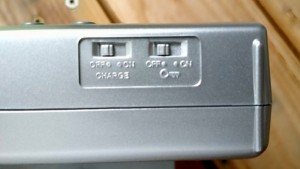
I bought one Sangean ATS-405, seems mine one also have the “DSP chirp” problem
I’ve had the ATS 405 for a year now. I find the AM to be very good. No birdies as you noted. I use a line antenna for SW, it definitely increases reception.
But I’ll tell you it’s a battery hog! The internal recharger doesn’t do as good a job on my Eneloops, it’s better to use a wall charger externally.
The sensitivity on AM I find outstanding!
It is too bad this radio didn’t have better sensitivity, especially since the most interesting programs are targeted towards Africa, South America and Asia.
I must update my initial findings about the ATS-405 in one important respect.
I have birdies… but not on 800 or 1600 kHz exactly. Thus I did not hear them when properly tuned. This took a bit of time as I was not checking into detuning signals for listening tweaks. With Soft-mute defeated this got put lower on the list of things to do. But I got there, and the birdies manifested themselves. And they are birdies.
In brief I would ask those responders/owners without birdies to try the following steps;
1.) Set to AM-BCB
2.) Set AGC to Auto
3.) Engage fine tuning (1kHz step)
4.) Tune to 1600 and press the up-arrow to fine tune/offset
5.) If you get no birdies, try tuning lower than 1600 kHz in the same manner
What I found was that at 1605 kHz on my receiver there was a strong birdie, and another on 802/803 kHz. YRMV, or have none at all.
Regards
Paul S. in CT
Is this a new ultralight DSP radio? Degen DE221.
http://www.ebay.com/itm/171874969571
Thomas,
Just checked for “birdies” on the three that I have.
Two have, one doesn’t.
K
I find it so funny that Sangean in the US seems to say something different from their office only a few minutes away.
I’ve owned the ATS-405 for about 10 days. No birdies on 800/1600. I would ask the reviewer to take the radio outside, away from the house by a good 50 feet and see if any birdies exist. Computers also being made in China are quite RF leak-prone. Mixed bag is not accurate. Away from the House, the set is exemplary. Inside the House mixed bag, but understand that any PL-310/380/505/606 would be intolerable in certain spots on the AM-band, like below 580kHz (deaf) and on certain CATV QRM regions, and Computer QRM locations. IMHO the QRM levels impact this, and most any other very-good or better receiver. The brutal test here is WGR 550kHz some 320 miles WNW of here. Deaf indoors with horrible QRM on a PL-310, and receivable with some QRM backgrounded on the ATS-405. The settings used will also contribute to a good or bad reception.
MHO: I suspect in the long run that there will be many ill-advised reviews of the 405, as reception settings can be made to appear both good and bad. /MHO
Hi, Paul,
I thought the same thing about the birdies, so when I first discovered them, I walked at least 100 feet from my house and they persisted. They’re the same level, so matter where I’m located. 800 kHz is a little less noticable than 1600 kHz, which is quite strong.
If your ATS-405 doesn’t have birdies, though, this indicates there well may be variations in quality control.
What is the serial number of your radio?
Thanks,
Thomas
Thomas,
Since Paul and Jay got good samples of the ATS-405, this implies that yours suffers from QC issues.
It’s possible some of the metal shields aren’t soldered down properly. I think Jay Allen had this problem with a recent Grundig radio that he reviewed. It’s too bad the customer rather than the manufacturer often ends up doing the QC testing on modern radios.
Regards,
Gary
I agree, Gary. In fact, Monday morning, I’m going to contact Sangean and see if they’ll send me another for comparison. Variations in QC are certainly a reality. I was just speaking with the owner of a ham radio store who said that the first and last production runs are the most prone.
Cheers,
Thomas
Thomas;
S# 51007238 on radio and box.
I had to travel about 1/2 mile away to get clear of Household QRM (large parking lot daytime). I have a weak Station daytime 800 WLAD , and WWRL 1600… no blips/chirps heard.
I forgot to mention I bought from ANT-online (Atlanta Network Technologies).
Hi, Paul,
I’ve heard back from a number of people who’ve stated that they hear no birdies or internally-generated noise on 800 and 1600 kHz. I strongly suspect my unit is simply a lemon.
Sangean has dispatched a sample for comparison.
I’m certain that the review unit I used in this particular review has internally-generated birdies because I’ve heard them throughout regional travels I’ve done over the past week. Same intensity, no matter where I’m located.
First thing I will check when I receive the new Sangean ATS-405 are birdies and noise floor levels.
-Thomas
Once I see the words “mixed bag” when reading a radio review the chance of me buying it = zero. Too bad because I absolutely love my Sangean ATS 909 and have had that radio for years with great performance.
Me too.
Looks like we won’t be doing an ATS-506 (updated 505 )
either,if it’s anything like this.
A shame.
You realize that 909 got (or should have gotten) described as a mixed bag too?
I recent did a review of the 405 and found it to very sensitive. Of course, sensitivity can vary a lot and is very subjective.
See my tests results here.
Hi, Tom, Can you check to see if you hear birdies on 800 and 1600 kHz? I actually posted a link to your review series recently!
Cheers,
Thomas